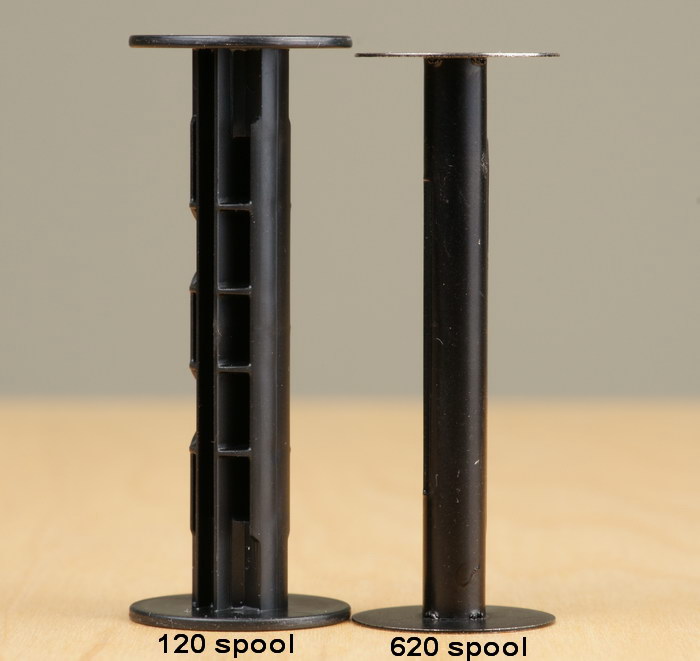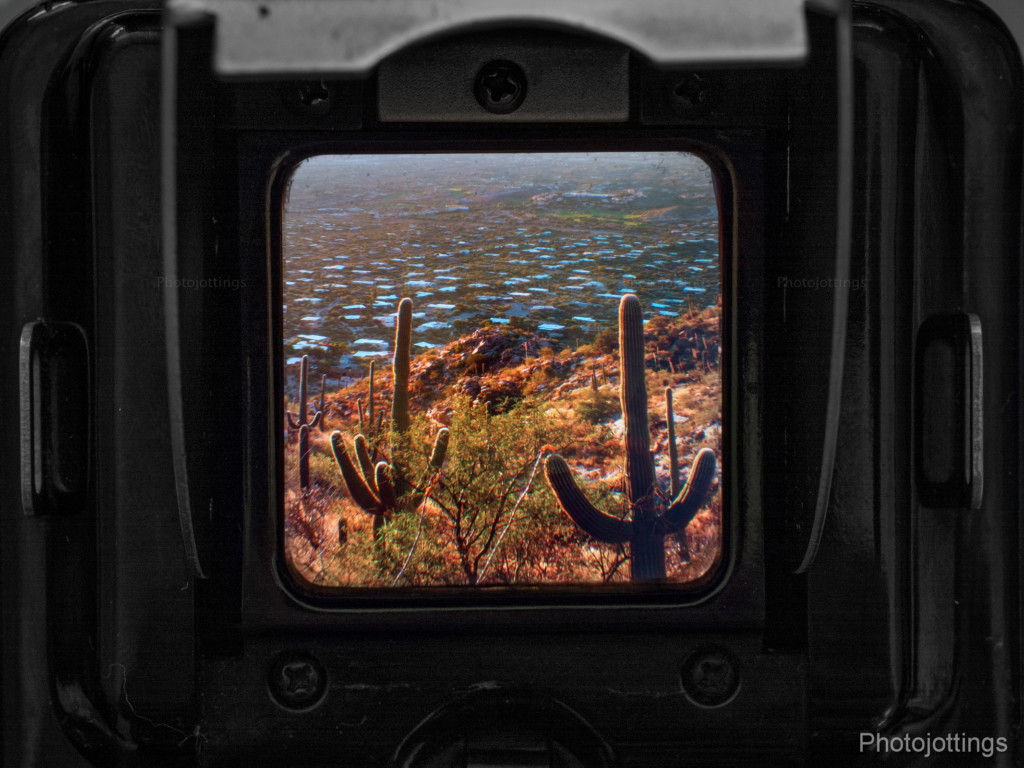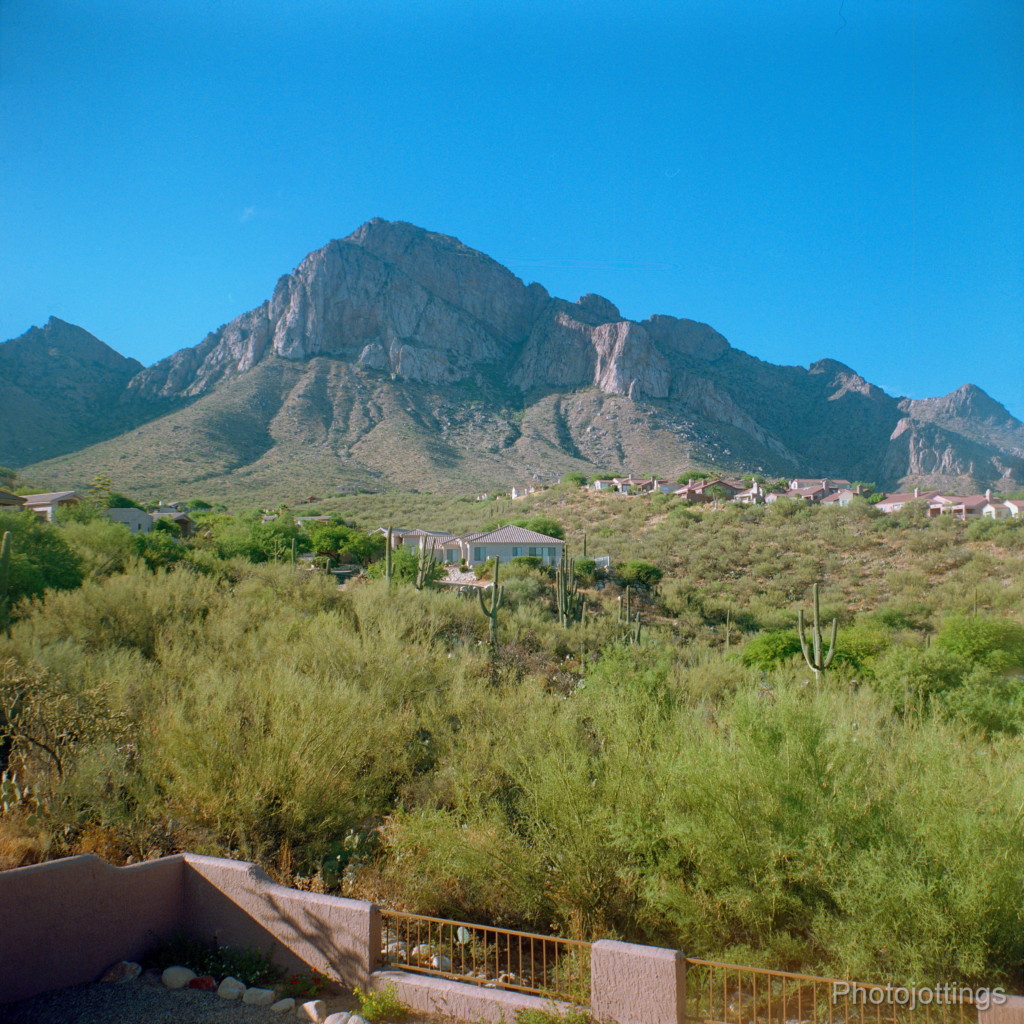
The Argus Super Seventy-Five (should’ve been named ‘Super Sixty-Five’ for obvious reasons) is a big step up from the ‘Seventy-Five’ and other fixed focus, fixed aperture fake ‘TLR’ type cameras. The ‘Super’ model includes a rare semi-wide angle 65mm three element lens with three waterhouse punched disk type stops to choose from, and the design is reminiscent of the Kodak Duaflex with 72mm F/8 Kodar. However, the Kodar has an achromatic doublet type with focusing front element, and the Argus Super 75 has an anastigmat lens according to the owner’s manual.
Argus has another camera I reviewed that’s very similar to the Super 75,’ it’s called the Argus Forty Both are fake ‘TLR’ types that use brilliant plano convex viewfinders that are not connected to the taking lens, or viewing lens for that matter, so they’re only used for framing the image, and not determining correct focus as you would on a real TLR. Like the ‘Forty,’ the ‘Super’ takes 620 film, but with a little finagling, you can just barely fit 120 spools in the supply side, and use 620 spools in the take-up compartment.
Speaking of framing, the ‘Super’ has a semi-wide angle 65mm lens which is never mentioned in the owner’s manual, and that omission may have been a result of using a viewfinder designed for the 75mm lenses, so you can’t see what you’re actually shooting with the 65mm lens. I suppose they did it out of economy, but it makes the camera quite a bit less useful when you can’t see the entire capture area for framing your subject properly. Maybe the 65mm lens was a last minute marketing ploy to try and distinguish it from the multitudes of other box cameras with 75mm lenses, and they kept the ‘Seventy Five’ name to avoid conflicts in their already printed marketing material. Oh well, who knows really, it’s just odd they called it the Super Seventy-Five instead of the Super Sixty-Five.
Argus calls this camera a ‘Super’ Seventy-Five; the regular ‘Seventy-Five’ is a simple fixed focus, fixed aperture box camera that looks very similar to the Super.
A 65mm lens on an box type 6×6 camera is pretty rare, So how does it perform? Read on, and be sure and check out the samples below.
Name; Argus Super Seventy-Five.
Manufactured by; Argus Cameras Inc, Ann Arbor, Michigan.
Made in; Ann Arbor, Michigan, USA.
Date of manufacture; Approximately 1954-1958?
Original Price; listed at $32.75 in a 1955 magazine ad for the camera outfit, which includes the flash, case, film batteries and some bulbs; that would be north of $375 today. Originally carried a one year manufacturers guarantee. Now about $15-$50 in good working condition on ebay.
Build material; Black Phenolic Resin (Bakelite) body, with bright aluminum trim. Back cover is cast metal. Fit and finish are very good.
Box contents; unsure, but probably the camera, instruction manual and neck strap only. The outfit came with; a leather case, flash gun, film, batteries, and bulbs.
Weight; my measurements, no film, 18.3oz (529g).
Dimensions; body is; 3.2″ (82mm) wide, 4.5″ (114mm) tall, and 3.0″ (75 mm) deep. With protrusions the dimensions are; height with hood open, 6.3″ (160mm), width at winding knob, 3.7″ (93mm), and depth with lens, 3.3″ (84mm).
Focal length; 65mm. About the same horizontal view as a 42mm lens in 135 format.
Aperture; punched disk type with three choices, F/8, 11 or 16.
Focusing distance; 3.5′ (1.1m) to infinity. Indicated marks at: 3.5′ – 4′ – 5′ – 6′ – 8′ – 10′ – 15′ – 25′ -50′ and ∞. Don’t forget to focus before each shot! Leaving the camera focused at 4′ and then taking longer distance landscape type shots results in very soft pictures.
Viewfinder; 1-3/8, (34x34mm) square plano convex glass, with flip-up hood. The viewfinder is not connected to the focusing lens, it’s only for composing the image. The angle of view is poor, so you must view it dead-center. Additionally, the viewfinder was made for the Argus 75mm lenses, so you can’t properly frame your subject with the 65mm lens. See framing differences below.
Approximate resolution; good film and technique will make sharp 16×20″ prints; and about the same as today’s better digital cameras with a cheap kit lens. See sample images farther down the page.
Distortion; very minor barrel distortion, see picture below.
Light fall-off; I see moderate “corner shading” at all apertures.
Color fringing; none that I notice.
Background blur or “bokeh;” ok I guess, I took one picture at close focusing, see below.
Lens; Argus Lumar, 65mm F/8, color corrected, hard coated anastigmat. The outer diameter of the lens ring near the body is 36mm, and about 35mm at the front knurled part; the manual states you can use Argus series VI filters with a 35mm slip-on adapter.
Shutter and speed; self cocking rotating shutter with a single speed of 1/65s, (my measurement) with ‘time’ and ‘instant’ settings.
Double exposure prevention. Yes, but no way to over-ride the system.
Film; 620 roll, but will take trimmed 120 rolls with a 620 take-up spool. Has a picture area of 56mm x 56mm. The “6×6” picture area is 3.6x larger than 135 film.
Flash; uses Argus 76 flash with two ‘C’ size batteries.
Power; none.
Accessories for this model; leather eveready case ($4.95), 76 flash unit ($4.25), and series VI 35mm adapter and filters; plus a ‘portrait’ and ‘copy’ lens attachment.
Crippling features and omissions; nothing really, it’s loaded with everything you need for good picture taking. I would like to see a cable release socket, but oh well.
Good features; bright viewfinder, choice of apertures, sharp lens and will take 120 film using a 620 take-up spool.
Quirks; the shutter button must be pushed in deeply to trip; in other words, there’s too much travel for my taste; however, I haven’t yet had a blurry shot.
Problems; none, and there isn’t much to go wrong with this model.
Other versions; lesser version is the Argus ‘Seventy Five’ with fixed focus and meniscus lens; and a more expensive model called the ‘Forty’ with the same body, but has a better lens and shutter.
Go here to see the owners manual and make sure you tip the site owner.
Product shots with descriptions. Click pictures for larger versions.

This nice looking camera sports a focusing lens, and a selection of three apertures. You can choose between ‘instant’ and ‘time’ exposures; ‘time’ is actually bulb, meaning you press and hold the button to keep the shutter open, and release to close. Without a cable release option, ‘time’ mode is not very safe to use as you can’t really keep the camera perfectly steady while holding in the shutter button, even on a tripod. The black shoelace neck strap in installed permanently; you have to take the camera apart to change it if it breaks.

The back of the camera has the required red window for properly advancing the film and setting the frame number. The viewfinder hood flips up by lifting the tab just above the back cover latch. Underneath the hood is an exposure guide for film back in the 1950s where ASA 32-80 was common. With modern ISO 200-400 films, I’d keep the aperture at F/16 for all daytime shots, and use smaller apertures for shadows and early morning or late afternoon.

Along the left side are two receptacles for attaching the flash gun. I don’t have the ’76’ flash available, but it appears to be a friction press fit design as I don’t see any threads; so make sure if you have a flash attached to hold on to both during use!

The coated Lumar lens has what Argus calls the ‘Redi-dot inside.’ This red dot shows up when you cock the shutter so you know the camera is ready to take pictures. Here the aperture is set to F/16, which is the sharpest setting for making large prints; but you can choose F/11 or F/8 for low light situations, or creating some background blur. Since the apertures are simply punched holes like waterhouse stops, you can’t use any ‘in between’ settings.

With the back cover open a number of things are visible; the film chamber is covered in flat black paint to avoid reflections. The take-up spool goes at the top, or left in this picture; if using 120 film, make sure you use a 620 spool here. The 120 supply spool goes in the lower chamber, or middle of the picture; it’s a very close fit and requires trimming the film ends a bit. The Super Seventy-Five has a real spring-loaded film pressure plate; visible attached to the back cover, but it”s not as good as the one on the ‘Forty’ model. The large round nipple by the pressure plate is for the ¼-20 tripod socket.

The knurled ring around the lens has an odd compound cut; I wonder if it was originally designed for a geared connection to the viewing lens? The colorful bars are for setting the proper flash distance with the corresponding aperture. Here you can see the green color bar underneath the 15′ mark, and the green F/8 colors off to the right; so this tells you that when your subject is in the range of 15′, you’ll need to use F/8 to get the proper flash exposure.
Below is some information on how to prep a 120 spool for loading into the supply side of this camera.

The 620 spool is shorter, but there’s still enough room inside the chamber for the 120 spool, so no modifications needed here.

Trim both spool ends of the 120 spool with a pair of common household scissors, cutting the outline as you see above. Use the deepest part of the scissors, towards your hand and make short “cuts” until you’re all the way around. This image is of a Kodak spool, Fuji uses a slightly different design, but you still trim off the same amount.

This image is also used in the Argus ‘Forty‘ review. The viewfinder is very bright when looking directly into it, even in low light. However, don’t judge the focus from this view; it’s always sharp, and used just for framing your shot. Also, the view is mirrored or reversed, meaning what’s on the right side in real life shows here on the left side, but you’ll instantly see this when viewing your shot.
Sample shots below.
All samples are displayed at 4000 x 4000 pixels wide when enlarged, and that’s all the resolution included in the film. Scanned on a Nikon Coolscan 9000 ED.
Here are a few samples for your viewing pleasure. Kodak Portra 400 film used. Click images for a larger version.

Close focused at the Lantana flower about 4′ away, and I think F/8.

Very mild barrel distortion, almost straight.

Old mud adobe home. Busted! I obviously took this from the comfort of my car, but man it was hot out. The viewfinder showed just the very edge of the mirror, that’s how much extra coverage you get with 65mm. Infinity focus, F/16.

Looks like a 1951 Hudson Hornet in faded Peacock green poly. I framed the car to the edges of the viewfinder, so you really get a lot more coverage than what you see. Focused at about 15-20 feet. F/16.

I can’t see Z Forrest through the viewfinder—properly. Here I was concentrating on getting the building only, not the roof extension. I see newton rings in the center of the sky and elsewhere from flat scanning the negative. Focused at infinity. F/16.

The cockroach of Tubac, how charming. I see a little light leak or something on the right edge by the door. Focused at 50 feet, F/16.
Here is the mountain test scene which I normally do in the late afternoon; but this time it’s in the morning, so the shadows and colors are different.

Contrast is lacking in this F/8 shot, but the central area is very sharp, and the whole image is totally useable; excellent performance for a cheap box camera.

F/11 shows more contrast, and a little more sharpness along the sides.

When stopped down to F/16, the whole image is quite sharp; except maybe the extreme sides.

I forgot and had the lens in ‘time’ mode while hand holding it, so the shutter opened for about a half a second before I knew what happened, and caused the blur. Here is the actual capture area of the lens. I framed only the window in the viewfinder, so the entire pink wall area is the coverage you don’t see; you have to keep that in mind when taking your pictures.
Conclusion.
The Super Seventy-Five is a fun camera, and it takes good quality pictures. I especially like the focusing front element and the three available apertures, that allows me to be a little more creative in my picture taking, just don’t forget to reset the focus for each shot! For the first roll I chose mostly F/16 for sharp landscape type shots shown above, but when you center your subject and focus correctly, F/8 looks sharp too, and you get a little background blur to make your subject stand out. I found the camera easy to hold and shoot, even with the somewhat slow shutter speed of 1/65s I was able to hold it steady and not get any blurry shots out of the entire roll. The viewfinder is bright and usable even in low light; much brighter than a real TLR, although you can’t check your focus.
Another nice feature about the Argus box cameras like the ones I’ve reviewed, (and probably not intended by Argus), is the cameras can use commonly available 120 film in the supply side by trimming the spool ends; it’s easy and takes a pair of scissors and about two minutes. The fit is pretty tight, and you have to do a little finagling to get it in correctly, but It can be done; that’s what I do to shoot these cameras. Make sure you have a 620 take-up spool. And make sure you get your spool back from the developer!!
The most unique part of the Super Seventy-Five is the 65mm lens. In 6×6 format 65mm is near wide angle territory, most 6×6 cameras have a lens of 75mm-85mm, so the coverage at 65mm is noticeably wider. The Argus Lumar lens is a little blurry along the sides at F/8, but at F//16 it looks quite sharp across the frame except for minor softness around the edges, usually more noticeable on one side or the other. The only downer about the 65mm lens is that Argus decided to save money and re-use the same viewfinders from their 75mm cameras, so you can’t see the extra coverage you get with the wider lens; but other than that, I see no flaws in the Super Seventy-Five.
Two thumbs up for the little Super Seventy-Five. But—I’m not finished taking pictures with this camera, I really like it. I’m already planing on using it for a couple of outings in the near future, and when I finish the rolls and scan the film, I’ll add the pictures and more info to the review.
That’s it for the Argus Super Sevent-Five review, get one from ebay, or a garage sale and have some fun! Please consider buying through my links and help support the site. Thanks for visiting!